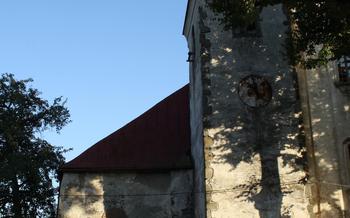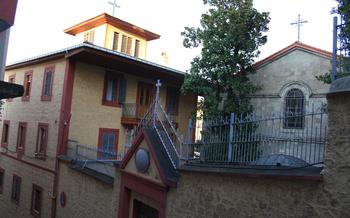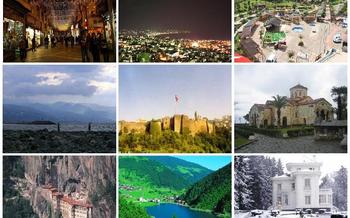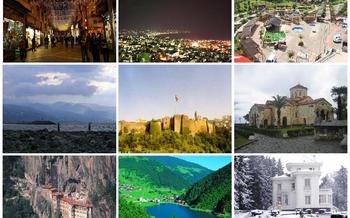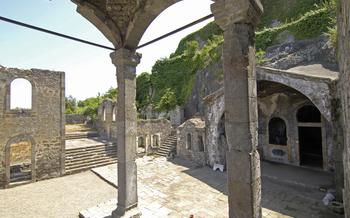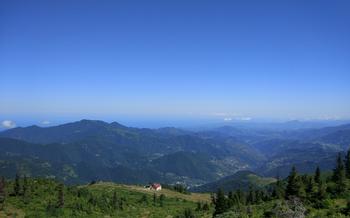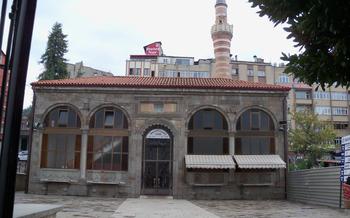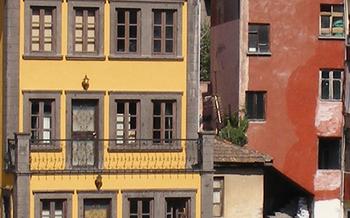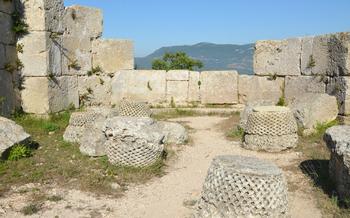
Trabzon Hagia Sophia Museum
- History of the Trabzon Hagia Sophia Museum: A Tale of Cultural Transformation
- Architectural Marvels
- Exquisite Frescoes and Mosaics
- Significance as a Religious Center
- UNESCO World Heritage Site
- Immersive Museum Experience
- Location and Accessibility
- Visiting Hours and Admission Fees
- Photography and Videography
- Guided Tours and Audio Guides
- Facilities and Amenities
- Dress Code and Etiquette
- Surrounding Attractions
- Insider Tip: The Secret Passageway
History of the Trabzon Hagia Sophia Museum: A Tale of Cultural Transformation
The Trabzon Hagia Sophia Museum stands as a testament to the rich and storied past of Trabzon, a city that has been a melting pot of cultures and civilizations for centuries. Originally constructed as a Byzantine church in the 13th century, this architectural marvel has undergone a remarkable transformation over the years, reflecting the diverse influences that have shaped Trabzon's history.
In the 15th century, with the conquest of Trabzon by the Ottoman Turks, the church underwent a significant transformation. It was converted into a mosque, with the addition of a minaret and other Islamic elements. The building's dual identity as both a place of Christian worship and an Islamic religious center symbolized the harmonious coexistence of different faiths in Trabzon during the Ottoman period.
In the 20th century, with the establishment of the modern Turkish Republic, the building underwent another transition. It was secularized and converted into a museum, open to visitors of all faiths and backgrounds. This transformation marked a new chapter in the history of the building, as it became a symbol of cultural diversity and religious tolerance in Trabzon.
The Trabzon Hagia Sophia Museum stands as a living testament to the dynamic history of Trabzon and the diverse influences that have shaped its cultural landscape. Its architectural evolution, blending Byzantine, Seljuk, and Ottoman elements, reflects the city's rich past and its role as a crossroads of civilizations.
Architectural Marvels
The Trabzon Hagia Sophia Museum is a testament to the architectural brilliance of the Byzantine era. Its stunning Byzantine-style architecture features intricate stone carvings that adorn the exterior walls, depicting religious scenes and historical figures. The interior is equally impressive, with colorful frescoes and mosaics adorning the walls and ceiling.
The museum's dome is a masterpiece of engineering and design. Supported by four massive pillars, it rises high above the sanctuary, creating a sense of awe and grandeur. The dome's interior is decorated with vibrant frescoes depicting biblical scenes and celestial beings.
The museum's unique blend of architectural elements from different eras is another highlight. The Seljuk minaret, added during the Seljuk period, stands as a symbol of the city's Islamic heritage. The Ottoman-era additions, such as the narthex and the madrasah, further enhance the building's architectural diversity.
The Trabzon Hagia Sophia Museum is a true architectural gem that showcases the rich cultural and historical heritage of Trabzon. Its unique features and stunning beauty make it a must-visit for anyone interested in Byzantine architecture and history.
Exquisite Frescoes and Mosaics
The Trabzon Hagia Sophia Museum is renowned for its breathtaking collection of frescoes and mosaics, which adorn the interior walls and ceilings with vibrant colors and intricate details. These artworks, created by skilled Byzantine artisans, depict biblical scenes, historical figures, and religious iconography, offering a glimpse into the beliefs and practices of the era.
The frescoes, with their lifelike portrayal of human figures and expressive faces, are particularly notable. They cover a wide range of subjects, from the life of Christ and the Virgin Mary to scenes from the Old Testament and the lives of saints. The vivid colors and the skillful use of light and shadow create a sense of depth and realism that is both captivating and awe-inspiring.
The mosaics, while less numerous than the frescoes, are equally impressive in their craftsmanship and artistic value. They feature intricate geometric patterns, floral motifs, and representations of religious figures. The vibrant hues of the tesserae, or small tiles used to create the mosaics, shimmer and reflect the light, adding a touch of brilliance to the interior space.
The frescoes and mosaics of the Trabzon Hagia Sophia Museum are not merely decorative elements; they serve as powerful tools for religious instruction and inspiration. They narrate stories from the Bible, convey theological concepts, and depict the lives of saints as models of Christian virtue. By studying these artworks, visitors can gain a deeper understanding of the beliefs and practices of the Byzantine era and appreciate the enduring legacy of Byzantine art.
The museum has undertaken extensive conservation efforts to preserve these precious artworks for future generations. Skilled conservators have meticulously cleaned and restored the frescoes and mosaics, ensuring that their colors and details remain vibrant for years to come. Thanks to these efforts, visitors can continue to marvel at the artistic and spiritual treasures of the Trabzon Hagia Sophia Museum.
Significance as a Religious Center
The Trabzon Hagia Sophia Museum holds immense religious significance, serving as a sacred space for both Christians and Muslims throughout history. Initially constructed as a Greek Orthodox cathedral in the 13th century, the building witnessed the devotion of Byzantine Christians for centuries. Its intricate frescoes and mosaics depicted biblical scenes and conveyed profound theological messages, reflecting the beliefs and practices of the Byzantine era.
During the Ottoman conquest in the 15th century, the church underwent a significant transformation, becoming a mosque known as the Fatih Mosque. This conversion involved the addition of Islamic elements, such as the construction of a minaret, a symbol of Islamic architecture. The minaret's elegant design and intricate tilework harmonized with the existing Byzantine architecture, creating a unique blend of styles.
Despite its conversion into a mosque, the building retained its sacred essence, becoming a place of worship for Muslims. The harmonious coexistence of Christian and Islamic influences within the same structure reflects the rich cultural and religious diversity that characterized Trabzon throughout history.
In the modern era, the Trabzon Hagia Sophia Museum stands as a secular institution, welcoming visitors of all faiths and backgrounds. It serves as a testament to the city's rich history and cultural heritage, showcasing the harmonious blending of Byzantine and Islamic traditions. Visitors can explore the museum's various sections, immersing themselves in the sacred atmosphere that has permeated its walls for centuries.
UNESCO World Heritage Site
The Trabzon Hagia Sophia Museum holds a prominent place among the world's cultural treasures, earning its designation as a UNESCO World Heritage Site in 20This prestigious recognition acknowledges the museum's exceptional cultural and historical value, meeting several stringent criteria set by UNESCO.
The museum's authenticity and integrity are key factors contributing to its World Heritage status. The building has undergone minimal alterations over the centuries, preserving its original architectural features and layout. The vibrant frescoes and mosaics that adorn its interior have also been carefully preserved, showcasing the artistic and theological expressions of the Byzantine era.
The museum's outstanding universal value lies in its unique blend of architectural styles and its representation of cultural diversity. The harmonious coexistence of Byzantine, Seljuk, and Ottoman elements within a single structure showcases the rich cultural heritage of Trabzon and the region.
As a UNESCO World Heritage Site, the Trabzon Hagia Sophia Museum carries the responsibility of preserving and protecting its remarkable legacy for future generations. This entails implementing strict conservation measures, conducting ongoing research and documentation, and raising awareness about the museum's significance.
The designation as a World Heritage Site also presents challenges in managing the delicate balance between preservation and accessibility. The museum must strike a balance between protecting its heritage value while ensuring that visitors can experience and appreciate its wonders without causing damage or compromising its integrity.
Through careful stewardship and collaboration with experts, the Trabzon Hagia Sophia Museum continues to fulfill its role as a symbol of cultural heritage and a source of inspiration for people worldwide.
Immersive Museum Experience
A visit to the Trabzon Hagia Sophia Museum is not just a historical exploration but an immersive journey into the past. The museum's engaging exhibits provide visitors with a comprehensive understanding of the building's history, architecture, and significance. Interactive panels and multimedia displays bring the stories of the past to life, allowing visitors to connect with the people and events that shaped this iconic landmark. Guided tours, led by knowledgeable and passionate experts, offer an in-depth exploration of the museum's highlights, including the stunning frescoes, intricate mosaics, and architectural marvels.
Whether you choose to wander through the museum's various sections at your own pace or join a guided tour, the experience is designed to captivate and inspire. The main sanctuary, with its soaring arches and magnificent dome, transports visitors back in time to the grandeur of Byzantine worship. The narthex, with its intricate carvings and vibrant frescoes, offers a glimpse into the daily lives of the people who frequented this sacred space. And the galleries, housing a collection of artifacts and historical documents, provide a deeper understanding of the museum's rich past.
My personal visit to the Trabzon Hagia Sophia Museum was a truly immersive experience. As I wandered through the museum's halls, I felt a profound connection to the history and culture that permeated every corner. The stunning frescoes, with their vibrant colors and expressive figures, seemed to come alive before my eyes, transporting me to a different era. The intricate mosaics, with their intricate patterns and religious iconography, captivated my attention, revealing the depth of craftsmanship and artistry that went into their creation.
Through the museum's engaging exhibits and knowledgeable guides, I gained a deeper appreciation for the Trabzon Hagia Sophia Museum's significance as a cultural and religious landmark. It is a place where history, art, and spirituality converge, offering visitors an unforgettable journey into the past.
Location and Accessibility
The Trabzon Hagia Sophia Museum is conveniently situated in the heart of Trabzon, making it easily accessible to visitors. It is located within walking distance from the city center, allowing for a pleasant stroll through the historic streets. Various transportation options are available to reach the museum, including public buses, taxis, and rental cars.
For those using public transportation, the nearest bus stop is just a short walk from the museum. Several bus lines pass through the area, providing easy connectivity from different parts of the city. Taxis are readily available and can be hailed from the street or ordered through a ride-hailing app.
If you prefer the flexibility of exploring the city at your own pace, renting a car is a great option. Several car rental agencies are located in Trabzon, offering a range of vehicles to suit different needs and budgets.
The museum's proximity to other historical sites and attractions in Trabzon is a significant advantage. Visitors can easily combine a visit to the Hagia Sophia with other must-see destinations, such as the Trabzon Castle, the Boztepe Hill, and the Uzun Sokak. This allows for a comprehensive exploration of the city's rich heritage and diverse attractions.
Visiting Hours and Admission Fees
The Trabzon Hagia Sophia Museum welcomes visitors from all over the world with open doors. The museum's hours of operation vary depending on the season. During the summer months (April to October), it is typically open from 9:00 AM to 7:00 PM. In the winter months (November to March), the hours may be shorter, from 9:00 AM to 5:00 PM. It is advisable to check the museum's official website or contact them directly for the most up-to-date information on visiting hours.
The admission fees for the Trabzon Hagia Sophia Museum are quite reasonable. For adults, the entrance fee is 60 Turkish Lira (approximately 10 USD). Students and children between the ages of 6 and 18 can enjoy a discounted rate of 30 Turkish Lira (approximately 5 USD). Children under the age of 6 are granted free admission. The museum also offers special discounts for groups and tour operators.
Whether you are a history buff, an architecture enthusiast, or simply a curious traveler, the Trabzon Hagia Sophia Museum is a must-visit destination. With its rich history, stunning architecture, and captivating exhibits, the museum promises an unforgettable experience for visitors of all ages.
Photography and Videography
The Trabzon Hagia Sophia Museum welcomes photography and videography for personal and educational purposes. However, to ensure the preservation and respect of this sacred space, visitors are kindly requested to adhere to specific guidelines.
Flash photography is strictly prohibited within the museum to protect the delicate frescoes and mosaics from damage. Using a tripod or monopod is also not permitted, as it may obstruct the paths of other visitors and damage the museum's floor.
When capturing images or videos, visitors should be mindful of their surroundings and avoid disturbing other guests or disrupting the serene atmosphere of the museum. Respecting the privacy of other visitors is essential, and photographing or filming individuals without their consent is not allowed.
To capture the best shots, visitors should take advantage of the natural light that filters through the windows, creating a beautiful interplay of light and shadow. The museum's intricate details and stunning architecture are best captured with a wide-angle lens, allowing you to encompass the grandeur of the space.
Remember, the Trabzon Hagia Sophia Museum is a place of historical and cultural significance, and visitors are encouraged to be respectful and responsible when documenting their experiences. By following these guidelines, you can contribute to the preservation of this treasured landmark while capturing lasting memories of your visit.
Guided Tours and Audio Guides
Enhance your visit to the Trabzon Hagia Sophia Museum by opting for a guided tour, available in multiple languages. These tours provide an in-depth exploration of the museum's history, architecture, and significance, led by knowledgeable guides who can answer your questions and offer insights.
Guided tours typically cover the main highlights of the museum, including the stunning frescoes and mosaics, the architectural features, and the religious significance of the site. They can last anywhere from 30 minutes to an hour, depending on the size of the group and the level of detail provided.
For a more personalized experience, consider renting an audio guide. These devices offer self-guided tours at your own pace, allowing you to explore the museum independently while listening to informative commentary at various points of interest. The audio guides are available in multiple languages and provide detailed explanations of the museum's history, architecture, and exhibits.
Whether you prefer the interactive experience of a guided tour or the flexibility of an audio guide, these options will enhance your understanding and appreciation of the Trabzon Hagia Sophia Museum, making your visit even more memorable.
Facilities and Amenities
The Trabzon Hagia Sophia Museum offers a range of facilities and amenities to enhance the visitor experience. Basic amenities such as clean and well-maintained restrooms and drinking fountains are available throughout the museum. Visitors can also take advantage of the comfortable seating areas scattered across the museum, providing a place to rest and reflect on the history and significance of the site.
For those seeking a deeper understanding of the museum, guided tours are available in multiple languages, led by knowledgeable and experienced guides who share insights and anecdotes about the building's history, architecture, and religious significance. Additionally, audio guides are available for self-guided tours, offering commentary and explanations at various points of interest within the museum.
The museum also features a well-stocked gift shop where visitors can purchase souvenirs, books, and replicas of artifacts to commemorate their visit. A cozy cafe is located within the museum grounds, providing a welcoming space for visitors to relax and enjoy refreshments while admiring the stunning views of the city and the surrounding mountains.
The Trabzon Hagia Sophia Museum is committed to accessibility for all visitors. Wheelchair ramps and elevators ensure that visitors with disabilities can easily navigate the museum's different levels. Designated parking spaces are also available for visitors with disabilities, located conveniently close to the museum entrance.
Dress Code and Etiquette
When visiting the Trabzon Hagia Sophia Museum, it is important to observe proper dress code and etiquette out of respect for its religious and cultural significance. Visitors should dress modestly, avoiding revealing or overly casual clothing. Shorts, tank tops, and flip-flops are generally not appropriate attire.
It is also important to maintain silence and minimize disruptions while exploring the museum's sacred spaces. Refrain from loud conversations, using flash photography, or touching the artifacts and artworks on display. Be mindful of other visitors who may be seeking a contemplative or spiritual experience.
By adhering to these guidelines, you can contribute to a respectful and enjoyable environment for all visitors to the Trabzon Hagia Sophia Museum.
Surrounding Attractions
The Trabzon Hagia Sophia Museum is conveniently located in the heart of Trabzon, surrounded by a wealth of historical and cultural attractions that make it an ideal starting point for exploring the city's rich heritage. A short walk from the museum, visitors can discover the imposing Trabzon Castle, a magnificent fortress that offers breathtaking views of the city and the surrounding mountains. The Boztepe Hill, another nearby attraction, provides a panoramic vista of Trabzon, the Black Sea, and the lush green valleys beyond.
For those seeking a deeper immersion into the local culture, Uzun Sokak, a charming street lined with traditional Ottoman-style houses, is a must-visit. This vibrant neighborhood is home to numerous shops, boutiques, and cafes, where visitors can browse for souvenirs, indulge in local delicacies, or simply soak up the lively atmosphere.
Exploring these surrounding attractions in conjunction with the Trabzon Hagia Sophia Museum offers a comprehensive journey through the history and culture of this fascinating city. Each site tells a unique story, adding layers of meaning and context to the visitor's experience. Whether it's marveling at the architectural grandeur of the castle, capturing stunning photographs from Boztepe Hill, or immersing oneself in the local life of Uzun Sokak, there's something for every traveler to discover in the vicinity of the Trabzon Hagia Sophia Museum.
Insider Tip: The Secret Passageway
For those seeking a hidden gem within the Trabzon Hagia Sophia Museum, venture to the inconspicuous door tucked away in the far corner of the main sanctuary. Behind this unassuming entrance lies a secret passageway that leads to a hidden chamber beneath the museum. This concealed space once served as a treasury, where valuable religious artifacts and treasures were stored. Today, it houses a small collection of artifacts discovered during the museum's restoration, offering a glimpse into the rich history and significance of this sacred place. Exploring this hidden chamber is like uncovering a secret chapter in the story of the Trabzon Hagia Sophia Museum, providing a unique and immersive experience for curious travelers.

